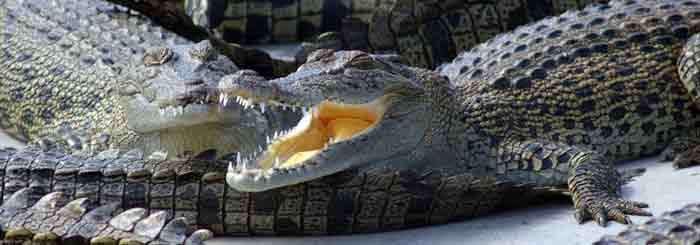Every year thousands of crocodile skins are exported from Australia to supply the world’s fashion industry. It has its critics but it is a lucrative industry that is tightly regulated by strict Australian laws protecting the import and export of wildlife and wildlife products.
Commercial crocodile farms are big business in Australia and the fashion industry pays good money for its first grade raw crocodile skins to make luxury handbags and other fashion accessories.
The biggest buyer of Australia’s crocodile skins is France, but Singapore and Indonesia come in second and third.
[headline size=”small” align=”left”]history of crocodile hunting[/headline]
 Commercial crocodile farms began to spring up in Australia in the 1970’s after legal hunting had resulted in a serious decline in wild crocodile numbers.
Commercial crocodile farms began to spring up in Australia in the 1970’s after legal hunting had resulted in a serious decline in wild crocodile numbers.
Farms were seen as a way to protect wild animals while continuing to supply the trade in crocodile skins.
Wild crocodile numbers have flourished since the ban on hunting was introduced and they are no longer considered to be in danger.
[headline size=”small” align=”left”]crocodile farming industry[/headline]
 Queensland has several commercial crocodile farms.
Queensland has several commercial crocodile farms.
Australia’s croc skins are considered to be the best quality in the world and fashion houses have bought farms here to secure their supply.
Hermes, a luxury fashion label owns several in North Queensland including the Cairns Crocodile Farm. Louis Vuitton owns a farm in Innisfail.
There are also farms in Western Australia and Northern Territory. Each farm has between 30,000-60,000 crocodiles at any one time, with anywhere up to 1,000 breeding crocodiles.
[headline size=”small” align=”left”]crocodile breeding[/headline]
To breed, farms either use captive breeding or ranching (also known as wild harvesting). Captive breeding is when adult crocodiles breed in a contained environment. Ranching is where eggs are removed from the wild and then harvested – this method is prohibited in Queensland.
 Young crocodiles are normally harvested or killed between the ages of two and four because their belly width at this age is around 35 to 45 centimetres. This is the size many fashion houses prefer for handbags as it minimises wastage of off-cuts.
Young crocodiles are normally harvested or killed between the ages of two and four because their belly width at this age is around 35 to 45 centimetres. This is the size many fashion houses prefer for handbags as it minimises wastage of off-cuts.
A local crocodile handler says that the older the crocodile gets, the larger its skin and the larger the scales.
“The fashion industry prefers the small delicate scales on the crocodile skins. Each one is unique with its own individual pattern. It takes three crocodile skins to make just one handbag, and then extra pieces of skin for the handles.”
He says while many people think the skin on the crocodile’s back is the most sought after, it is actually the skin on the belly and between the four legs that buyers want.
[headline size=”small” align=”left”]market values[/headline]
 The actual price of crocodile skins vary and while crocodile farms are reluctant to talk about how much they sell their skins for, an overall consensus suggests prices range from $600 per skin up to around $1,000 for exquisite skins.
The actual price of crocodile skins vary and while crocodile farms are reluctant to talk about how much they sell their skins for, an overall consensus suggests prices range from $600 per skin up to around $1,000 for exquisite skins.
The grading of the skin affects its value. A first grade skin with no blemishes or damage will cost more than a marked or damaged skin.
[headline size=”small” align=”left”]travel nq fast facts:[/headline]
- There are 22 species of crocodile in the world. Australia has two, the saltwater crocodile and the freshwater crocodile.
- Hartley’s Crocodile Adventures near Port Douglas has a commercial farm as part of its operation so visitors can learn about the industry as well as conservation.
- Crocodile farms are closely regulated and administered under the Environment Protection and Biodiversity Conservation Act 1999. All farms require a license and permits are required to export crocodile products. Australia is a member of CITES (Convention of International Trade in Endangered Species).


